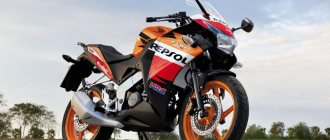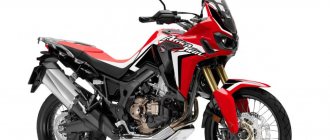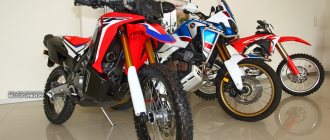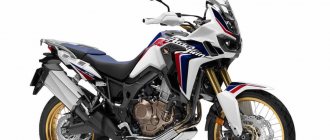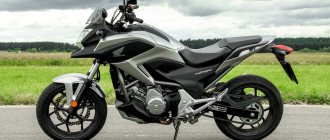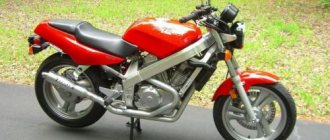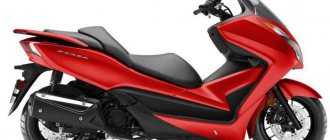| Honda CB650F (2014-2019) |
Model of the budget naked motorcycle Honda CB650F
was first presented in 2013 at the EICMA-2013 exhibition, and went into production in 2014. It was this motorcycle that replaced the legendary Honda CB600F Hornet, which has been no longer produced since 2012.
The Honda CB650F was based on the platform and engine from the new Honda CBR650F model, which is an in-line 4-cylinder liquid-cooled unit producing 87 hp. power and 63 Nm of torque. The engine is noticeably derated for its volume and produces maximum performance at 8000-11000 rpm. The engine is tuned for confident traction from low and medium speeds.
The features of the Honda CB650F include a steel diagonal frame, conventional non-adjustable suspension in the form of a telescopic fork and a monoshock absorber (adjustable only by preload), as well as combined brakes with ABS.
Assessing the technical characteristics and equipment of the Honda CB650F, one immediately notices the budget nature of the motorcycle and its focus on pilots of different levels - from beginners to experienced ones. All this, coupled with a modern aggressive design, should ensure a decent level of motorcycle sales - especially since its price is one of the cheapest in its class.
Comparing the Honda CB650F with the latest generation Honda Hornet 600, a desire to save as much as possible is clearly evident: a common base and engine with the CBR650F model; although diagonal, it is still a steel frame; instead of an inverted fork - a regular one. However, this fact is quite normal - remember the first versions of Hornet: the same derated engine, but from a Honda CBR600F3; the same steel frame; the same simple pendants. It’s just that over time, the Honda CB600F Hornet turned from a budget motorcycle into a full-fledged flagship model, using more and more parts from the sports version of the Honda CBR 600 RR. Although it was developed and positioned itself as a budget motorcycle for the city. The situation with the Honda CB650F is similar.
2019 was the final year of production of the Honda CB650F, after which it was replaced by the new Honda CB650R (available in 2019).
The main competitors of the Honda CB650F in the class:
- Kawasaki ER-6N
- Suzuki GSF 650 Bandit
- Yamaha XJ6 Diversion N
Brief history of the model
- 2014 - start of production and sales of the Honda CB650F model.
Model:
Honda CB650F / CB650FA (All regions).
Frame number:
MLHRC75X*XXXXXXXX~, RC83-XXXXXXX (Japan).
Factory designation:
CB650FE, CB650FAE.
- 2015 - no significant changes.
Model:
Honda CB650F / CB650FA (All regions).
Frame number:
MLHRC75X*XXXXXXXX~, RC83-XXXXXXX (Japan).
Factory designation:
CB650FF, CB650FAF.
- 2016 - no significant changes.
Model:
Honda CB650F / CB650FA (All regions).
Frame number:
MLHRC75X*XXXXXXXX~, RC83-XXXXXXX (Japan).
Factory designation:
CB650FG, CB650FAG.
- 2017 - by optimizing engine settings, maximum power increases to 89.7 hp and torque to 64 Nm.
Model:
Honda CB650F / CB650FA (All regions).
Frame number:
MLHRC75X*XXXXXXXX~, RC83-XXXXXXX (Japan).
Factory designation:
CB650FH, CB650FAH.
- 2018 - no significant changes.
Model:
Honda CB650F / CB650FA (All regions).
Factory designation:
CB650FJ, CB650FAJ.
- 2019 is the last year of production.
Model:
Honda CB650F (ABS) (South America).
Factory designation:
CB650FAK.
Calm “predator”
The new Honda CB650F has been pacified in some respects and sharpened in others. We still have four gold exhaust manifolds going into one short muffler that ends just below the right footrest. It's a very aesthetic trend to keep exhaust systems far behind the passenger footrest. Finishing the muffler basically just below the engine gives the bike a massive look and enhances the impression of a compact figure. The engine exhaust covers match perfectly with the gold exhaust manifolds, also in a gold-copper hue. He was all dressed in red, black and silver lacquer colors.
Honda CB650F
Honda CB650F
Compared to its predecessor, the new CB650F looks more massive thanks to the reduction of the side and front fairing. Thanks to them, the golden engine comes to the fore, and the motorcycle seems more dangerous than it really is. It also strengthens the bulbous tank and shortens the front fender. Overall it gives the impression of being predatory, but without exaggeration.
Honda CB650F
Honda CB650F
Specifications
Technical characteristics of Honda CB650F:
| Model | Honda CB650F |
| Motorcycle type | naked |
| Year of issue | 2014-2019 |
| Frame | steel |
| engine's type | 4-cylinder, 4-stroke, in-line |
| Working volume | 649 cm³ |
| Bore/Stroke | 67.0 x 46.0 mm |
| Compression ratio | 11,4:1 |
| Cooling | Liquid |
| Number of valves per cylinder | DOHC, 4 valves per cylinder |
| Fuel supply system | electronic injection PGM-FI, 32 mm |
| Ignition type | transistor |
| Maximum power | 87 hp (64 kW) at 11000 rpm 89.7 hp. (66 kW) at 11000 rpm - CB650F (from 2022) |
| Maximum torque | 63 Nm (6.4 kg*m) at 8000 rpm 64 Nm (6.5 kg*m) at 8000 rpm - CB650F (from 2022) |
| Clutch | Multi-disc in oil bath, cable drive |
| Transmission | 6-speed |
| type of drive | chain |
| Front tire size | 120/70-ZR17 M/C (58W) |
| Rear tire size | 180/55-ZR17 M/C (73W) |
| Front brakes | 2 discs 320 mm, 2-piston calipers (ABS) |
| Rear brakes | 1 disc 240 mm, 1-piston caliper (ABS) |
| Front suspension | 41 mm telescopic fork, travel - 120 mm |
| Rear suspension | pendulum with monoshock absorber (preload adjustment), stroke - 127 mm |
| Length | 2110 mm |
| Width | 775 mm |
| Height | 1120 mm |
| Wheelbase | 1450 mm |
| Seat height | 810 mm |
| Minimum ground clearance (clearance) | 150 mm |
| Acceleration 0-100 km/h (0-60 mph) | 3.3 sec[1] |
| Maximum speed | 210 km/h[2] |
| Gas tank capacity | 17.3 l |
| Motorcycle weight (curb) | 206 kg - CB650F 208 kg - CB650FA (ABS) |
Changes
The new generation Honda CB650F received, among other things, a new Showa Dual Bending Valve front fork. Both front and rear lighting were made using LED technology. Also, the Nissin front brake pads have been improved so that when braking with one finger, we can stop the bike without putting much force on it.
Honda CB650F
Honda CB650F
Chassis and brakes
The motorcycle is equipped with a stylish steel frame, which is designed in the best traditions of the naked class. The rims of such a futuristic-looking bike are, of course, alloy, because spokes would simply look ridiculous. As for the steering wheel, there is nothing remarkable about it, except for the aggressive shape of the mirrors.
The rear suspension is a pendulum version with a monoshock absorber, and the front is a 41 mm telescopic fork. At the rear, the CB 650 F uses a single-piston caliper with a 240 mm disc for braking, while at the front there are two double-piston calipers with two 320 mm discs.
Honda CB650R 2022 design
The design of the Honda Neo Sport Café (CB650R) clearly shows influence from the café racers of yore.
The Honda CB650R has a chopped front fender, LED headlight and daytime running lights. The handlebars have moved slightly forward and down to give the motorcycle a sporty and aggressive look, which does not interfere with a comfortable upright position. There is a new LCD dashboard with all the main indicators. The charm is added by the “cheeks” of the small side fairings. The fuel tank with recessed knees, saddle and top line of the frame are one with aggressive lines. The rear is less severe, with a small step separating the pilot's seat from the passenger seat. At the rear we also see folding steps on a subframe, a large taillight and a long mudguard, the end of which is crowned with turn signals and a license plate. Overall, the lines of the Honda CB650R are reminiscent of classic city motorcycles.
Honda CB650R – Neo Sport Cafe
Magnificent “four”: review of Honda CB650 Neo Sports Cafe
The debut of the new Honda CB 650 Neo Sports Cafe in our market was quiet - last year’s premiere of the flagship naked CB1000R Neo Sports Cafe made much more noise, the motorcycle aroused genuine interest. And the “six hundred”, despite the fact that it is trying in every possible way to be like its older “liter” brother, is lost. Why?
It seems that, despite all the efforts of the Russian Honda office, positioning the Honda CB650 Neo Sports Cafe as a new model, motorcyclists considered the well-known CB650F, which replaced the six hundred cc Hornet on the production line in 2014, as a “new product”. A good motorcycle, the excessive design simplifications in which were more than compensated by incredible reliability and phenomenal service life.
Video version of the Honda CB650 Neo Sports Cafe test drive:
What really could not be forgiven about the Hornet 600, and then the CB650F, was its lack of character. And even though this average car was famous for its balance and harmony, every now and then you felt like yawning while driving. The same applied to the design - a motorcycle with a less emotional appearance still needed to be looked for, the Japanese tried to create a look that everyone would like, but in the end it turned out to be such a commonly used type with a black and white orientation that no one liked it.
At the Honda CB 650 Neo Sports Cafe, the comments were taken into account; the face underwent serious plastic surgery. Yes, one design is spread across three motorcycles at once - 1000, 650 and 300 cc. Yes, without revelations and frills, such as can be seen in roadsters like the Husqvarna Vitpilen, but quite relevant, neat and pleasant. The motorcycle looks better than before, and the diode headlight with a horizontal bar, elongated turn signals and elegant radiator covers, together with a reduced tail, are worthy of a “good” rating.
The monochrome dashboard, reminiscent of a large smartphone, also looks good. And although a tape tachometer with a digital speedometer is not something you would dream of, readability and information content are at the level. In addition to data on temperature and fuel reserve, the on-board computer will show the time, the selected gear, and a bunch of other minor data, there is a blinker, in other words, decent functionality.
The main feature of the CB650F has also been preserved - the comb of mufflers, a quartet of pipes extending sideways in formation before merging into one can. The taste and color of the markers are different, but at least no other motorcycle manufacturer has such a solution. In an era of sameness and unification, even such a small thing deserves attention. It definitely suits the Honda CB 650 Neo Sports Cafe.
In the saddle, the motorcycle has hardly changed. The steering wheel of variable diameter, mounted in struts with dampers, is spacious, and the saddle, narrowed at the base and widening along with the rise closer to the tail, allows not only tall, but also short pilots to feel confident. You can spend more than one hour here before you feel tired.
The remote controls also look good - the keys are wide and graceful, like blossoming petals. The only complaints are the grumbling of the owner of the old rice mills - instead of the turn signal joystick that has moved down, there is now a horn key in the center of the left console, and the key under the left index finger, which was responsible for briefly turning on the high beam, now turns the traction on and off, you can blink the “high beam” only with its on key . Matter of habit.
But traction is the first significant innovation that catches your eye; it was not present on the old motorcycle. As the second decade of the 21st century approaches, old women are less and less afraid of microwaves, and real bikers are increasingly less likely to associate safe riding with driving skills, more often trusting their lives to software and hard drives. In other words, it's high time! Looking ahead, I will say: when installing traction, the Japanese left room for future upgrades, so the pilot does not have the opportunity to customize the response mode. But it is possible to turn it off completely, thanks for that!
But the engine, at first glance, has not changed, the same 649 cc inline 16-valve “four” with two camshafts and a timing chain, identical in sound and behavior. At least until you unscrew the gas handle all the way and the revolutions reach the middle of the tachometer tape. Until this moment, as before, absolutely nothing happens; the engine starts producing something tangible at about six thousand. Here the Honda CB 650 Neo Sports Cafe picks up the rising breeze, giving it enough lift to take off.
With the sound of an aircraft turbine up to 11,000 rpm, the engine seems to be justifying its failure at the bottom, working for two. By remembering the traditional ideal clarity of gearbox shifts more often, you can drive quickly. Much faster than the old CB650F. And don’t think that the problem is in the engine, although it is in that too - the increase in output from 87 to 95 forces is felt, although it does not fundamentally change anything.
I assure you, if the engineers had kept the peak values at the same level, no one would have noticed, but everyone would have started driving faster. Why? It's all about the chassis, which, next to the engine, was made a little more interesting without fundamentally changing. As before, the motorcycle is based on a steel frame and an aluminum pendulum with a monoshock absorber, but the traditional telescopic fork has given way to a rigid “inverted” one. And although adjustments have not appeared with the new design on the Honda CB 650 Neo Sports Cafe, the modern front suspension adds sharpness and confidence.
On the new “Sibikha” you want to bend over more often and deeper than on the old one. I want to ride on it, choosing roads with more twists and turns, you can safely increase the pace, it’s a fairy tale! The brakes also changed, following the new level of chassis and engine, the brakes also took a step forward: a pair of “floating” two-piston front calipers gave way to powerful four-piston calipers, rigidly fixed to radial mounts.
With them came excellent feedback, linearity and responsiveness - no longer need to press hard on the handle, trying to guess how much force you need to apply to the handle to stop right at the stop line at that traffic light. Evolution! It seems that the standard ABS system has become a little more modern, however, it clearly does not live up to the latest generation.
What's annoying about the new Honda CB 650 Neo Sports Cafe is the intrusiveness of the traction control. While Europeans have long abandoned annoying systems that cut off ignition or fuel in favor of smooth and imperceptible throttle valves, the Japanese system insultingly abruptly ends your acceleration for the amusement of another street racer in a filthy car-sharing BMW.
You don’t even need slippage, which traction is designed to combat, just a hint of it is enough. A slight lift of the front wheel from the asphalt, a quarter of a turn slipped on the markings, a horoscope advising Capricorns to be wary of highsides, electronics throwing an ugly tantrum for any reason. Ignoring it is not an option - it will take a long time until the computer realizes that the danger has passed.
It’s quicker to agree, let go of the throttle and unscrew it again, or turn off this damn stabilization altogether, after all, it’s only six hundred, it’s June, the asphalt is clean and the tires are hot. However, in November I would like to cut through rotten leaves, Sobyanin’s shampoos and water that hardens as the thermometer approaches sub-zero values with just such a sensitive and obsessive traction; I have grown from the age when I want to freeze my ears to spite my grandmother.
I think she would approve of my purchase of a Honda CB 650 Neo Sports Cafe. And what? Quite a reasonable choice - not a lot of motor, but enough. You can drive fast and dynamically, but driving headlong and acting up on the road is no longer so good. The brakes are fire, the chassis is on point. And the price tag is 726,000 rubles. Not a little, but compared to classmates it’s quite competitive. Charisma? Although it has become larger compared to its predecessor, my heart does not beat faster at the appearance of the new item.
Thank you for your help in organizing the test.
Command Center
The clock in the Honda CB650F is transparent and convenient. On the left screen you will see a tachometer and speedometer. On the right is a digital indicator of fuel level, mileage, clock and warning lights. Integrity is transparent and does not overload information.
Honda CB650F
Honda CB650F
Honda CB650F
Control
In terms of driving, the Honda doesn't surprise - it still handles as confidently and effortlessly as its predecessor. However, compared to the quasi-competitive (and my personal favourite) Yamaha MT-07 (which however has a twin-cylinder engine and a 16bhp downgrade), it's a bit more raw. The mass does its job. The Honda isn't just massive at first glance - it weighs 208kg (including full oil and fuel tanks), while the MT-07 is 26kg smaller at 182kg. However, despite the correct weight, the Honda is light and enjoyable to drive.
Honda CB650F
Honda CB650F
Honda CB650F
Honda CB650F
The subtle facelift is out of town Honda for good. The motorcycle has become more expressive, which will certainly appeal to many drivers. Despite the menacing first impression, the CB650F is not a devil on wheels, but rather a pretty ass that everyone willingly goes for a walk with.
Post Views: 4,024
For whom
Here are the main features of this bike:
- Ease of use;
- reliability;
- sustained classic style.
The motorcycle is perfect for those who have already mastered bikes a little in general and want to purchase a machine that will serve them faithfully for many years on city streets and country roads. But we must not forget that this is by no means an all-terrain vehicle.
